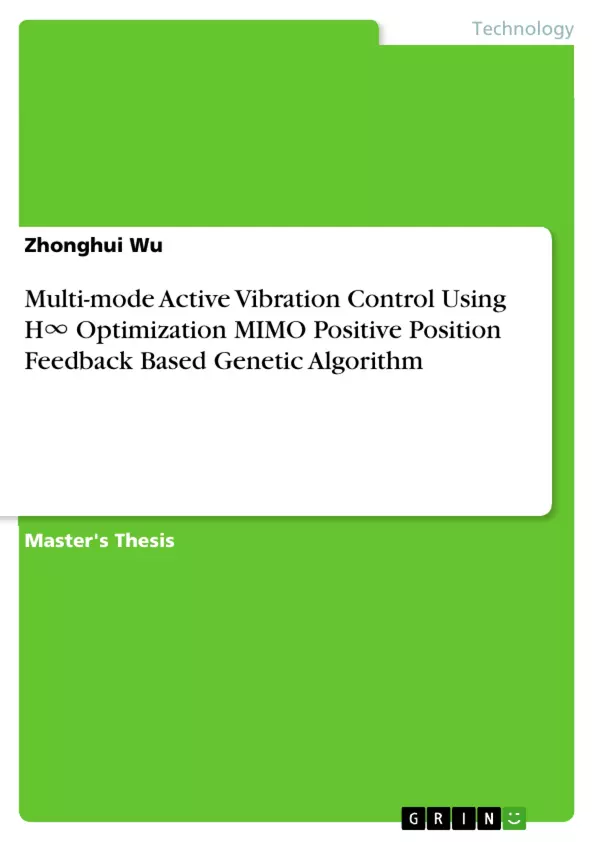In this thesis, experimental, analytical and numerical analysis are used for distributed parameter plate structure modeling, an infinite-dimensional and a very high-order plate mathematical transfer function model is derived based on modal analysis and numerical analysis results. A feed-through truncated plate model which minimizing the effect of truncated modes on spatial low-frequency dynamics of the system by adding a spatial zero frequency term to the truncated model is provided and numerical software MATLAB is used to compare the feed-through truncated plate model with traditional balanced reduction plate model which is used to decrease the dimensions and orders of the infinite-dimensional and very high-order plate model.
Active vibration control strategy is presented for a flexible plate structure with bonded three self-sensing magnetic transducers which guarantee unconditional stability of the closed-loop system similar as collocated control system. Both multi-mode SISO and MIMO control laws based upon positive position feedback is developed for plate structure vibration suppression. The proposed multi-mode PPF controllers can be tuned to a chosen number of modes and increase the damping of the plate structure so as to minimize the chosen number of resonant responses.
Stability conditions for multi-mode SISO and MIMO PPF controllers are derived to allow for a feed-through term in the model of the plate structure which is needed to ensure little perturbation in the in-bandwidth zeros of the model. A minimization criterion based on the H∞ norm of the closed-loop system is solved by a genetic algorithm to derive optimal parameters of the controllers. Numerical simulation and experimental implementation are performed to verify the effectiveness of multi-mode SISO and MIMO PPF controllers’ vibration suppression for the feed-through truncated plate structure.
Frequently asked questions
What is the main topic of this document?
This document is a comprehensive language preview concerning active vibration control, particularly focusing on modal-based controllers, positive position feedback (PPF), and their implementation on flexible plate structures. It includes the title, table of contents, objectives and key themes, chapter summaries, and keywords.
What are the key themes explored in the "Introduction" chapter (Chapter 1)?
Chapter 1 discusses the motivation for the research, the research methodology used, a literature review, the thesis outline, and a list of original contributions. It highlights the challenges in controlling flexible structures due to their distributed parameter nature, spillover effects, and the difficulty in designing wide-band controllers.
What is the experimental plant described in Chapter 2?
Chapter 2 describes an experimental plant consisting of a flexible aluminum plate mounted on an MDF board using three electromagnetic transducers, with another transducer acting as a disturbance shaker. The chapter details the physical characteristics, mechanical parameters, and electrical parameters of the transducers used.
What modeling techniques are used in Chapter 2?
Chapter 2 uses analytical analysis, experimental measurements, and numerical analysis (using ANSYS) to model the flexible plate structure. It includes a description of the ANSYS model setup, modal analysis, and harmonic response analysis.
What is the focus of Chapter 3?
Chapter 3 discusses spatial norms and model reduction techniques, specifically focusing on balanced truncation for reducing the complexity of the plate model while preserving its essential dynamics. It also touches upon feed-through truncation which minimizes the effects of truncated modes.
What is the topic of Chapter 4?
Chapter 4 presents a model correction approach aimed at improving the accuracy of the reduced-order plate models. It focuses on minimizing the error between the full-order model and the reduced-order model by adding a zero-frequency term.
What are the main concepts discussed in Chapter 5?
Chapter 5 delves into the design and analysis of multi-mode SISO and MIMO Positive Position Feedback (PPF) controllers. It covers the PPF controller structure, closed-loop stability analysis (including scalar and multivariate cases), and parameter selection methods using MATLAB optimization toolbox and Genetic Algorithm (GA) optimization search.
What does Chapter 6 cover?
Chapter 6 presents simulation results obtained from using the designed multi-mode SISO and MIMO PPF controllers. The simulations aim to verify the effectiveness of the proposed control methods in reducing vibrations, particularly impulse and step responses. The simulations are analyzed by using both time and frequency domain data.
What are the experimental results presented in Chapter 7?
Chapter 7 focuses on the experimental implementation and results of the multi-mode SISO and MIMO PPF controllers. It discusses the self-sensing technique used, electronics components, dSpace implementation, interfacing circuits, and experimental results achieved by the implementation of controllers, both in SISO and MIMO configurations.
What specific aspects of the experiment are detailed in Chapter 7?
Chapter 7 details the experimental setup, including self-sensing using transducers, electronics including dSpace, interfacing circuits, and additional electronics. It also displays a comparative table with specific measurement results for Multi-mode SISO experiments.
What future work is suggested in the Conclusion chapter (Chapter 8)?
Chapter 8 proposes several avenues for future research including implementing adaptive active vibration control, adding more transducers for improved control, employing higher performance piezoelectric sensors and actuators, accurately remodeling the complex transducer structure, and performing an optimal positioning analysis on the transducers using genetic algorithms.
- Citar trabajo
- Master of engineering by research Zhonghui Wu (Autor), 2014, Multi-mode Active Vibration Control Using H∞ Optimization MIMO Positive Position Feedback Based Genetic Algorithm, Múnich, GRIN Verlag, https://www.grin.com/document/334980



